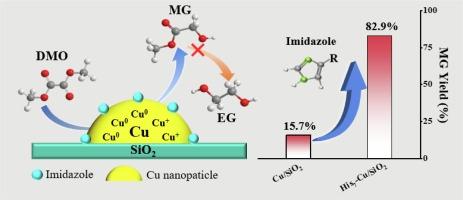Histidine-derivate modified Cu/SiO2 catalyst for selective hydrogenation of dimethyl oxalate to methyl glycolate
IF 6.7
1区 工程技术
Q2 ENERGY & FUELS
引用次数: 0
Abstract
Cu-based catalysts are extensively employed in dimethyl oxalate (DMO) hydrogenation, but it is rather challenging to obtain methyl glycolate (MG) over traditional Cu-based catalysts with high selectivity at high DMO conversion. Herein, the physicochemical properties of the typical Cu/SiO2 catalyst and its corresponding catalytic performance toward DMO hydrogenation were tuned by surface modification with a biological template (histidine). On the premise of near-total conversion of DMO, the MG selectivity substantially increased from 15.7 % to 82.9 % when the typical Cu/SiO2 catalyst was modified by 7 wt% histidine, which was fairly impressive among the reported results up to now. Furthermore, comprehensive characterization and kinetic study disclosed the underlying mechanism. After thermal treatment, histidine retains its skeleton framework (imidazole), the emerging Cu–N interaction weakened the Cu-silica interaction, leading to the reduction in percentage of Cu+ and increase in electron density on the Cu/SiO2 catalyst. As a result, the adsorption and activation ability toward MG were obviously suppressed, which was proved as the critical step for selective hydrogenation of DMO toward MG.

组氨酸衍生物修饰的 Cu/SiO2 催化剂用于草酸二甲酯选择性加氢生成羟基乙酸甲酯
铜基催化剂被广泛应用于草酸二甲酯(DMO)加氢反应,但要在传统的铜基催化剂上获得具有高选择性、高 DMO 转化率的乙醇酸甲酯(MG)却相当具有挑战性。本文通过使用生物模板(组氨酸)进行表面修饰,调整了典型 Cu/SiO2 催化剂的理化性质及其相应的 DMO 加氢催化性能。在DMO接近完全转化的前提下,典型的Cu/SiO2催化剂经7 wt%组氨酸改性后,MG选择性从15.7%大幅提高到82.9%,这在目前已报道的结果中相当引人注目。此外,综合表征和动力学研究揭示了其基本机理。热处理后,组氨酸保留了其骨架框架(咪唑),新出现的 Cu-N 相互作用削弱了 Cu-Silica 相互作用,导致 Cu+ 在 Cu/SiO2 催化剂上的百分比降低,电子密度增加。因此,对 MG 的吸附和活化能力明显受到抑制,这被证明是 DMO 对 MG 进行选择性氢化的关键步骤。
本文章由计算机程序翻译,如有差异,请以英文原文为准。
求助全文
约1分钟内获得全文
求助全文
来源期刊

Fuel
工程技术-工程:化工
CiteScore
12.80
自引率
20.30%
发文量
3506
审稿时长
64 days
期刊介绍:
The exploration of energy sources remains a critical matter of study. For the past nine decades, fuel has consistently held the forefront in primary research efforts within the field of energy science. This area of investigation encompasses a wide range of subjects, with a particular emphasis on emerging concerns like environmental factors and pollution.
 求助内容:
求助内容: 应助结果提醒方式:
应助结果提醒方式:


